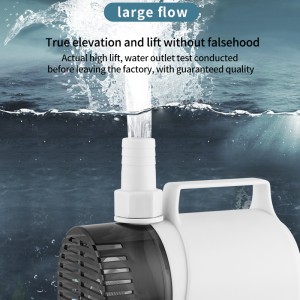Submersible pumps are the silent workhorses hidden deep in wells or tanks, reliably delivering water where it’s needed. But like any hardworking machine, they need regular attention to perform their best and avoid costly breakdowns. So, how often should you roll up your sleeves? The truth is, there’s no single perfect schedule that fits every pump. It depends heavily on several factors:
1、How Much You Use It: A pump running constantly for irrigation will need more frequent checks than one used occasionally for topping up a garden pond.
2、What You’re Pumping: Water quality is crucial. Pumps in sandy or silty water need much more frequent attention (filter cleaning, impeller checks) than those in clean water. Water with high mineral content (hard water) can lead to faster scaling buildup.
3、The Pump’s Quality and Age: A well-built, professionally installed pump might go longer between major service intervals than a cheaper model or one nearing the end of its expected lifespan. Older pumps generally need more vigilant monitoring.
4、The Environment: Harsh conditions (high temperatures, potential for debris) warrant more frequent checks.
5、Monthly Quick Checks (Especially for Critical/Heavy-Use Pumps):
Listen: Briefly turn the pump on. Does it sound smooth and consistent? Any grinding, screeching, or unusual vibrations? Unusual noises are early warning signs.
Monitor Performance: Notice any drop in water pressure? Does the pump run longer than usual to fill a tank? Is your electricity usage spiking unexpectedly? These can indicate reduced efficiency or developing problems.
Check Control Systems: Ensure pressure switches, controllers, and float switches (if used) are operating correctly.
6、Quarterly to Semi-Annual Checks (Every 3-6 Months for Average Use in Clean Water):
Inspect Above-Ground Components: Check wiring connections in the control box for corrosion or heat damage. Verify pressure tank pre-charge if applicable. Look for leaks in pipes or fittings.
Consider Professional Inspection (If Accessible): If your setup allows relatively easy retrieval (e.g., shallow well), a visual inspection of the intake screen or filter by a professional during this interval can be very beneficial for pumps in moderate use.
Regardless of any schedule, immediate inspection or service is warranted if you notice:
- Significant drop in water pressure or flow rate.
- Pump cycling on and off rapidly (short cycling).
- Unusual noises (grinding, screeching, loud humming).
- Pump failing to start or tripping circuit breakers.
- Sand or sediment suddenly appearing in your water.
- A noticeable increase in electricity consumption.
The Bottom Line: Consistency is Key
Think of submersible pump maintenance like changing the oil in your car. Skipping it saves a little time and money now but risks a major, expensive failure later. For the vast majority of users, an annual professional inspection and service is the single best practice to ensure optimal performance, maximize lifespan (often 8-15 years or more), and provide peace of mind. For pumps under heavy load or in harsh conditions, increase that frequency to semi-annually. Combine this professional care with your own monthly vigilance – listening and watching for performance changes – and your submersible pump will reward you with years of reliable, efficient service. Don’t wait for it to fail; proactive care is always cheaper and less disruptive than an emergency replacement.
If you want to learn more about this, please contact our website https://www.jingyeaquarium.com/
Post time: Jun-12-2025

